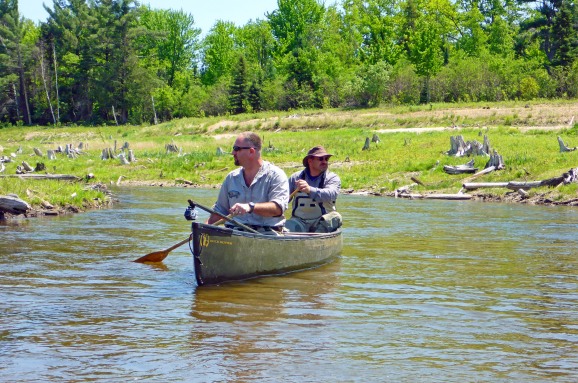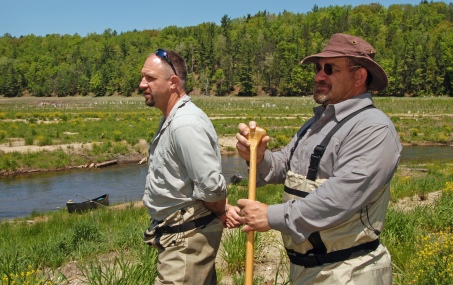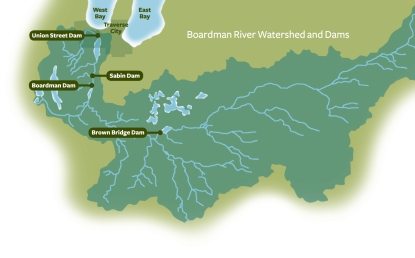
Frank Dituri (left) and Bret Fessell kneel in Grasshopper Creek where they find signs of aquatic insect life that was not there before the Brown Bridge Dam was removed. Photo: Howard Meyerson
By Howard Meyerson
While picking through the natural debris on the bottom of Grasshopper Creek, a tiny stream feeding the upper Boardman River, two scientists with the Grand Traverse Band of Ottawa and Chippewa Indians began to get excited.
Brett Fessell and Frank Dituri both noted things that made them hopeful. Fessell is the tribe’s fish and wildlife coordinator. Dituri is their wetland ecologist. He is also chairman of the multi-jurisdiction implementation team guiding the Boardman River restoration. The multi-million dollar project involves removing three dams and modifying a fourth over the next several years. Brown Bridge Dam, most upstream, was the first to go in 2013.
The three of us were canoeing though the 2.8 mile restoration area, the zone that was underwater prior to removing the dam. The former pond and backwaters, where paddling was once slow and laborious, had reverted to being a quick-moving river – today a joy to paddle.
What these scientists had discovered in streambed, set in a wild tangle of forest, were the empty cases of caddisfly larvae that had emerged, tiny conical structures made of fine gravel, found only in running water. Trout food, essentially; at very least, an indication of bugs that trout love.
“This place (the creek bottom) was all filled with mud,” Fessell explained, admiring the fresh gravel bed that was uncovered once the muck washed out, pushed by faster stream velocities made possible after pond waters went down.
“Now you have all these little pockets and pools – same as a larger river – and just as important for fisheries. This is going to be better spawning and nursery habitat. I am confident we will see more brook trout.”

Brett Fessell (front) and Frank Dituri explore the Boardman River restoration zone by canoe and see plenty of new growth. The tree stumps were left from 1800’s logging efforts prior to construction of the Brown Bridge Dam. Photo: Howard Meyerson
Dituri was enthusiastic. He is one of many implementation team members who are monitoring the process, a group including representatives from the Michigan DNR, U.S. Fish and Wildlife Service, City of Traverse City, Grand Traverse County, Traverse City Light and Power, and Michigan Hydro Relicensing Coalition.
“What we see here are the upper-end effects of removing the dam,” Dituri elaborated. “When the water was backed up, the river was a foot and half higher. Two years ago, Grasshopper Creek didn’t look like this at all. This is a wonderful benefit.”
What is true on Grasshopper Creek is also true on the Boardman River. More gravel now shows along the river bottom above the former dam site – providing more habitats for spawning trout. The river flows faster. Silt, sand and sediment are flushed downstream more readily.
We floated on, further down river, into the flood plain exposed by draining the pond – a wide-open landscape littered with thousands of bleached-out stumps that offer a compelling look at Michigan history, to an era before the dam when rapacious loggers cut everything in sight.
“Logging started here in the 1830’s and 40’s,” Dituri recalled. “We have photos of this area with not one tree. Everything was gone.”
Thick forests line the banks high above the river hinting at the future. New greenery

Brett Fessell (left) and Frank Dituri look over lands that were under water until a year ago when Brown Bridge Dam was removed. Photo: Howard Meyerson
appears all around the stumps at river level, a far different picture than the black muck shown in photos last year right after the dam was removed. Some of the vegetation is natural. Most of it, Dituri explains, is enhanced by native seeds and trees that have been planted as part of the restoration.
In the distance I see tall poplar stands, the product of last year’s plantings. They are twice the height of those planted this year. Restoration crews have planted 1,700 trees so far this year, a mix tamarack, cedar and red oak, among others, Dituri said.
“It’s going to take a while,” Fessell says as if reading my mind once we get out of canoes and climb the bank. He then shared a story about a stranger he overheard a year ago; someone who looked on at the black exposed muck and said ‘What a tragedy.’
“I wish I could look those folks up a year later and have them stand in the same spot and ask how they feel,” Fessell states wistfully. “It (nature) is like that. How this stuff comes back – its humbling. It will come back just fine.”
“At the end of this summer or next year you won’t be able to see long stretches of river anymore because of the growth,” Dituri adds. “It will be 30 to 50 years before we have trees large enough to grow up and fall down and have the feel when paddling through here that you have in the upper stretch of river. It’s a lifetime opportunity to watch something like this.”
There and then I vowed silently to return, to paddle the river each year and witness the ongoing recovery. To see it is to believe, someone once said. And what I saw gave me hope for the rest of the Boardman River as well.
____________________________________
This story appears on MLive Outdoors.


Great success story! Wish we’d remove some of our damns here in NB.
LikeLike
I was planning on heading up to Traverse City next month. Guess I’ll have to take the kayak’s along.
LikeLike
mfs686…do take it – you won’t regret it.
LikeLike